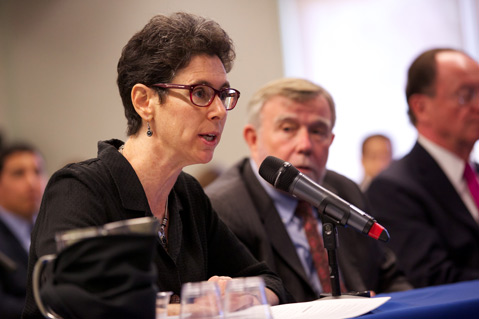How to Make College More Affordable?
Williams and Education Experts Trade Ideas During UCSB Event
On Monday at UCSB’s Loma Pelona Center, education experts, students, faculty, and others concerned about making college more affordable and accessible presented several solutions — both short- and long-term and fiscal and non-fiscal — to Assemblymember Das Williams and members of the California Assembly Higher Education Committee.
The three-hour hearing included testimony from several experts from the California Student Aid Commission, the Legislative Analyst’s Office, the Institute for College Access and Success, and the Western Interstate Commission for Higher Education (WICHE).

WICHE President David Longanecker kicked off the talk with a presentation, “The Case for Whopping Big Change,” in which he explained to policymakers that the demand for higher education currently exceeds the supply. Historically, California was able to pay and provide for every college student, Longanecker said, but the state is no longer wealthy enough to offer the “generosity it once provided to the public good.” The current funding approach, he said, cannot be sustained. To illustrate his point, Longanecker quoted eternal academic Albert Einstein: “Insanity: doing the same thing over and over again and expecting different results.”
Calling California “average” in terms of per capita income and tax revenue, and “slightly above average” in higher education support, Longanecker suggested a “shared responsibility” in picking up the college tab between the state (through Cal Grants), the student (through part-time, minimum-wage jobs), the student’s family (when possible), the federal government (through under-utilized Pell Grants), and the institution that the student attends.
Another speaker, Dr. Jamillah Moore, representing both the California Student Aid Commission and the Ventura County Community College District, gave a presentation about the accessibility of Cal Grants: More than half of the 685,000 new and renewal students who qualified for an award received one.
Debbie Cochrane, representing the Institute for College Access & Success, used the Bay Area as a case study to demonstrate the distribution of Cal Grants. The maximum 1st year Cal Grant covers 8 percent of total costs for recipients attending Berkeley City College, 22 percent of total costs for recipients attending CSU East Bay, and 43 percent for those attending UC Berkeley. Although UC Berkeley’s tuition is roughly $7,000 more than that of CSU East Bay’s and roughly $11,000 more than that of Berkeley’s City College, cost of living for students attending any of the three schools is relatively similar, meaning community college students face substantial affordability challenges and are more likely to be underserved by state aid.
A few of the speakers supported higher fees and a stricter financial-aid model for community colleges to ensure students have access to classes they need to graduate on time. Williams recently authored a controversial bill — currently waiting for the governor’s signature — which would implement a trial period for six California community colleges, allowing them to charge about $200 per unit for certain high-demand classes. The bill’s opponents say higher rates for college classes put low-income students at a greater disadvantage.
“The longer it takes someone to do a four-year degree, the more likely they are to drop out, or the more likely they are to incur student debt,” Williams explained. “So affordability has to be looked at not just in the sense of tuition and fees. … We are putting them at risk. Affordability is meaningless if we don’t have room for the students to go at all.”
Representing state schools, CSU Channel Islands President Richard R. Rush spoke about the need for policymakers to restore funding. Tuition is fairly low for CSU schools, and the system has had to turn down 20,000 to 28,000 eligible students — roughly one out of 15 qualified applicants — because of lack of space. Rush also suggested public-private partnerships as a short-term option.
Textbook rentals, online materials, and strategic advising to saving money were presented as non-fiscal options to tackle lack of funding. Another non-fiscal solution was streaming lectures, which would free up professors and keep costs down. The problem with that potential solution, one public commenter later noted, was that the professor actually costs less than several teaching assistants required to teach discussion sessions and grade papers and exams.
Several students also spoke and “gave a face to the statistics,” speaking about their personal experiences. After the hearing, Williams said he was pleased with the turnout and solid ideas presented. He encouraged people to suggest ideas to policymakers as they have until January to draft new legislation.


